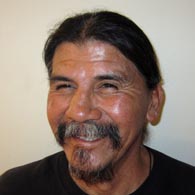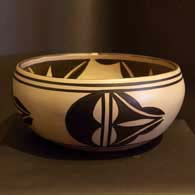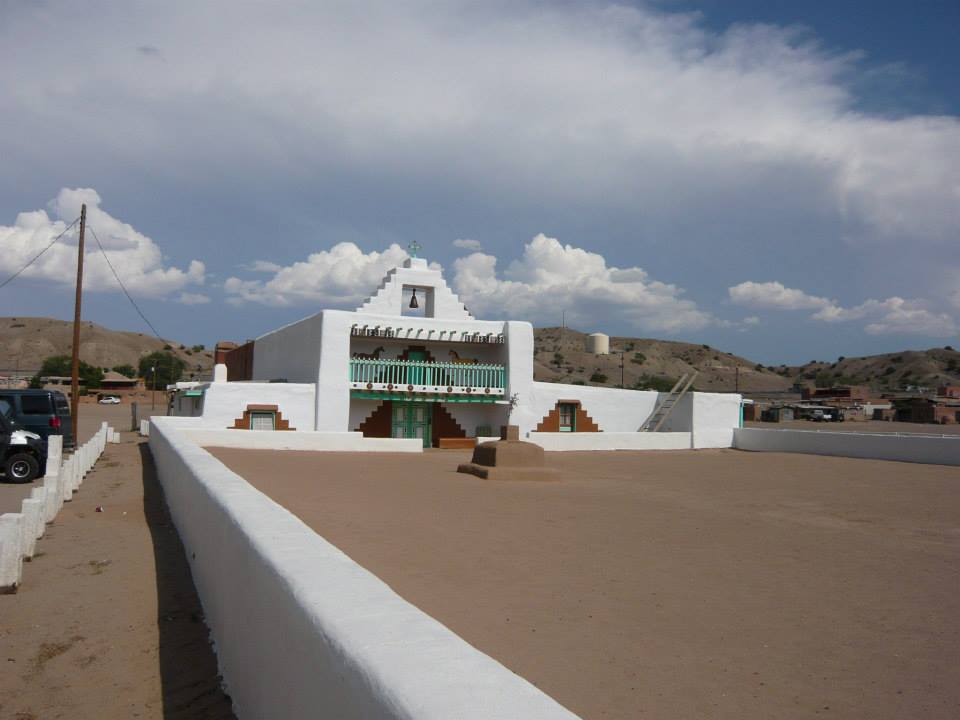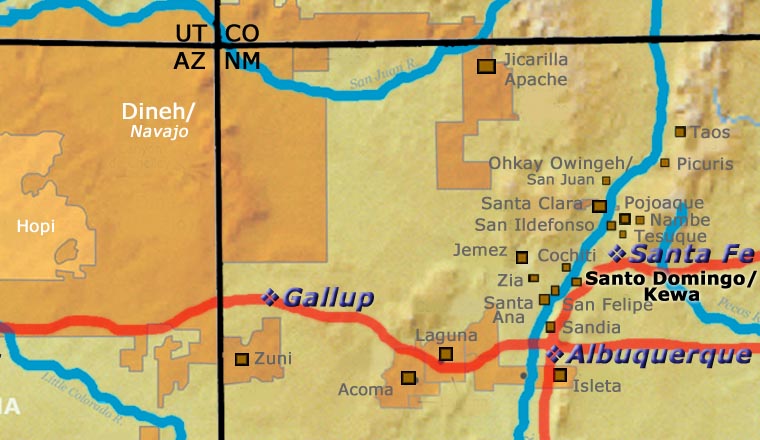
Ambrose Atencio
Santo Domingo

Ambrose Atencio was born to Joseph Ray Atencio and Juanita Atencio of Santo Domingo Pueblo in June, 1963. He told us he learned the traditional method of making pottery from his cousin, Robert Tenorio (and his family), starting around the time Ambrose was 13 years old. The years since then Ambrose has spent perfecting his technique. His progression is reflected in the perfect shape of his pots and in his exquisite execution of the traditional Santo Domingo designs that he chooses to use.
He collects the basic materials to make his pottery on the lands of Santo Domingo Pueblo. When his pieces are finished and ready, Ambrose ground fires his work using cottonwood bark, like his grandmother, Crucita Tortalita (Robert Tenorio's maternal aunt), used to do. He's also taught his son Elroy to work with clay in the traditional way.
Ambrose has earned multiple awards at venues such as the Indian Arts Northwest Market in Portland, Oregon, the Fountain Hills Indian Market in Fountain Hills, Arizona, the Eight Northern Indian Pueblos Arts & Crafts Show in Espanola, New Mexico, the Dallas Indian Arts and Crafts Fair in Dallas, Texas, the Santa Fe Indian Market (where he's taken home ribbons for Best of Class, Best of Category and others), and the Heard Museum Guild Indian Art Fair & Market in Phoenix (where he's won several ribbons).
Ambrose tells us his favorite shapes to make are storage jars and large dough bowls. He also really enjoys decorating them with traditional Santo Domingo birds, plants, animals and geometric designs. Like many Native American traditional potters, he says his inspiration comes from above, through the clay.
When he's not busy making new pots Ambrose says he enjoys hiking. On special occasions he enjoys music concerts, a favorite one having been a Fleetwood Mac concert on his birthday.
He signs his work: "Ambrose Atencio KEWA" and adds the date the pot was created.
Other Awards Ambrose has Won
- 2004 Santa Fe Indian Market, Class. II - Pottery, Div. E - Traditional pottery, jars, including wedding jars, Cat. 1204 - Jars, Santo Domingo or Cochiti, Third Place;
- Div. F - Traditional pottery, painted designs on matte or semi-matte surface, all forms except jars, Cat. 1302 - Other bowl forms, Second Place - 2001 Santa Fe Indian Market, Class. II - Pottery, Div. E - Traditional pottery jars, Cat. 1204 - Jars, Santo Domingo or Cochiti, First & Second Places
100 West San Francisco Street, Santa Fe, New Mexico 87501
(505) 986-1234 - www.andreafisherpottery.com - All Rights Reserved

Santo Domingo Pueblo

Santo Domingo Pueblo Mission Church
Santo Domingo Pueblo is located on the east bank of the Rio Grande about half-way between Santa Fe and Albuquerque. Historically, the people of Santo Domingo were among the most active of Pueblo traders. The pueblo also has a reputation for being ultra traditional, probably due, at least in part, to the longevity of the pueblo's pottery styles. Some of today's popular designs have changed very little since the 1700s.
In pre-Columbian times, traders from Santo Domingo were trading turquoise (from mines in the Cerrillos Hills) and hand-made heishe beads as far away as central Mexico. Many artisans in the pueblo still work in the old ways and produce wonderful silver and turquoise jewelry and heishe decorations.
Like the people of nearby San Felipe and Cochiti, the people of Santo Domingo speak Keres and trace their ancestry back to villages established on the Pajarito Plateau area in the 1400s. Like the other Rio Grande pueblos, Santo Domingo rose up against the Spanish oppressors in 1680, following Alonzo Catiti as he led the Keres-speaking pueblos and worked with Popé (of San Juan Pueblo) to stop the Spanish atrocities. However, when Spanish Governor Antonio Otermin returned to the area in 1681, he found Santo Domingo deserted and ordered it burned. The pueblo residents had fled to a nearby mountain stronghold and when Don Diego de Vargas returned to Nuevo Mexico in 1692, he attacked that mountain fortress and burned it, too. Catiti died in that battle and Keres opposition to the Spanish crumbled with his death. The survivors of that battle fled, some to Acoma, some to fledgling Laguna, some to the Hopi mesas. Over time most of them returned to Santo Domingo.
In the 1790s Santo Domingo accepted an influx of refugees from the Galisteo Basin area as they fled the near-constant attacks of Apache, Comanche, Ute and Navajo raiders in that area. Today's main Santo Domingo village was founded about 1886.
In 1598 Santo Domingo was the site of the first gathering of 38 pueblo governors by Don Juan de Oñaté to try to force them to swear allegiance to the crown of Spain. Today, the All Indian Pueblo Council (consisting of the nineteen remaining pueblo's governors and an executive staff) gathers at Santo Domingo for their first meeting every year, to continue what is now the oldest annual political gathering in America. During the time of the Spanish occupation Santo Domingo served as the headquarters of the Franciscan missionaries in New Mexico and religious trials were held there during the Spanish Inquisition.
Today, the people of Santo Domingo number around 4,500, with about two-thirds of them living on the reservation. The pottery traditions of the pueblo almost died out after the railroads arrived and many Santo Domingos went to work laying tracks. Even today many Santo Domingo men work as firefighters for the US Forest Service in fire season and practice their artistic talents during the rest of the year.
Potter Robert Tenorio began working to revive the Santo Domingo pottery tradition in the early 1970s. His influence can be found among many of today's Santo Domingo potters, even if they say he only stimulated them to learn on their own.
While today's Santo Domingo pottery is known for designs described as simple geometrics, another outstanding feature is boldness: the lines are thick and well-defined. In the 1920s, Kenneth Chapman, from the Museum of New Mexico, went to Santo Domingo and made drawings of many of the designs that were being painted on Santo Domingo pottery "before they disappeared." Thomas Tenorio said he got most of his designs from that collection.
As religious leaders forbid the representation of human figures as well as other sacred designs on pottery made for commercial purposes, birds, fish and flowers are common design motifs. Depictions of mammals are rarely seen. Another typical Santo Domingo style is to paint in the negative, meaning cover the pot in panels of big swatches of black and red so that only a few lines of the cream slip show through.
100 West San Francisco Street, Santa Fe, New Mexico 87501
(505) 986-1234 - www.andreafisherpottery.com - All Rights Reserved

Tenorio Family Tree
Disclaimer: This "family tree" is a best effort on our part to determine who the potters are in this family and arrange them in a generational order. The general information available is questionable so we have tried to show each of these diagrams to living members of each family to get their input and approval, too. This diagram is subject to change should we get better info.
-
Clemente & Nescita Calabaza (maternal side) & Andrea Ortiz (paternal side)
- Juanita Calabaza Tenorio (1922-1982) & Andres Tenorio
- Mary Edna Coriz (1946-) & Luciano Coriz
- Angel Bailon (1968-) & Ralph Bailon
- Paulita Pacheco (1943-2008) & Gilbert Pacheco (1940-2010)
- William Andrew Pacheco (1975-)
- Rose Pacheco (1968-) & Billy Veale (Dineh)
- Robert Tenorio (1950-)
Among Robert's students:
- Ambrose Atencio
- Corine Lovato
- Hilda Coriz (1949-2007) & Arthur Coriz (1948-1999)
- Ione Coriz (1973-)
- Warren Coriz (1966-2011)
- Mary Edna Coriz (1946-) & Luciano Coriz
-
Gilbert Pacheco's sisters who became potters:
- Laurencita Calabaza
- Santana Calabaza
- Trinidad Pacheco
- Vivian Sanchez
- Laurencita Calabaza
Some of the above info is drawn from Southern Pueblo Pottery, 2000 Artist Biographies, by Gregory Schaaf, © 2002, Center for Indigenous Arts & Studies
Other info is derived from personal contacts with family members and through interminable searches of the Internet and cross-examination of the data found.
(505) 986-1234 - www.andreafisherpottery.com - All Rights Reserved
